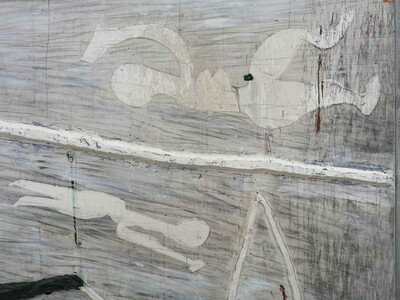This artwork revolves around the Chinese character “又,” which has been deconstructed, reshaped, and reassembled in a free-flowing manner. Bold lines intersect and redefine its structure, creating a visual composition that balances contrast and continuity. Beneath its seemingly simple form lies a layered narrative, rich with meaning.
On the left side, fractured material takes center stage, with red lines tracing its cracks—a deliberate tribute to the natural beauty of these ruptures. Inspired by the ice-crack patterns found in ancient ceramics, these fissures are a result of sudden temperature shifts. Though each material fractures differently, the patterns they form share an uncanny similarity. Yet, what fascinates me most is that no two cracks are ever identical, much like the neural networks in the human brain. By capturing these natural fractures, the work hints at a deeper connection—between the intricate web of the universe and the evolving landscape of artificial intelligence.
In contrast to the stillness of the fractured forms, three bold lines cut across the composition. Within them, rapid strokes of pencil and charcoal intertwine, sketching out fleeting, human-like figures caught in constant motion. These restless lines evoke the flow of time, the rhythm of history, and the endless crossing of individual paths—an ever-repeating cycle of movement and return.
On the far right, smudged traces of charcoal dust, applied by hand, add yet another dimension. In Chinese tradition, the Kitchen God, enshrined above the stove, ascends to the heavens each year to report on the affairs of mortals, offering blessings in return. The ashes from the fire—born from withered plants and crops, consumed by flames—rise into the air, only to settle back into the earth, nourishing the soil and allowing new life to flourish. This quiet, unassuming cycle mirrors the greater rhythm of the cosmos: everything is connected, nothing is ever truly lost, and existence is an endless ebb and flow of creation and dissolution.
At first glance, the composition may seem straightforward, but the deeper you look, the more it reveals. The right side, where charcoal lines and human figures emerge, still bears the traces of raindrops, a quiet dialogue between warmth and cold, yin and yang. On the left, the broad expanse of the canvas isn’t empty—it holds the imprint of my own hands, the smudged charcoal carrying the residual touch of the artist, a subtle but undeniable link between creator and creation. If you look closely, you might even catch glimpses of animals, heart-like forms, and other fleeting symbols embedded within the piece.
This work, in its own way, speaks of something fundamental: that nothing in this world happens by chance. From the smallest speck of dust to the vast expanse of the cosmos, everything is intertwined in ways both seen and unseen.
Detail pictures:




